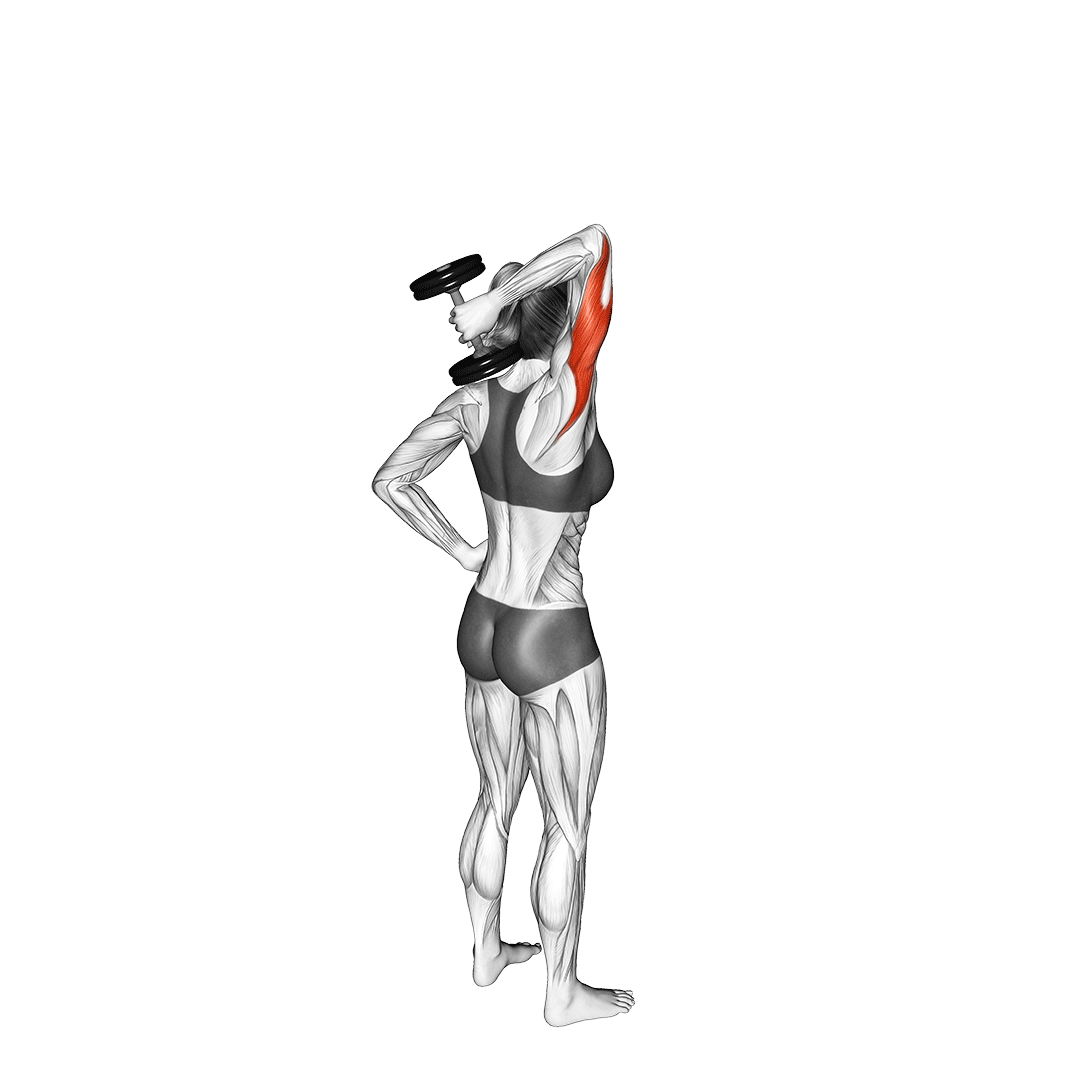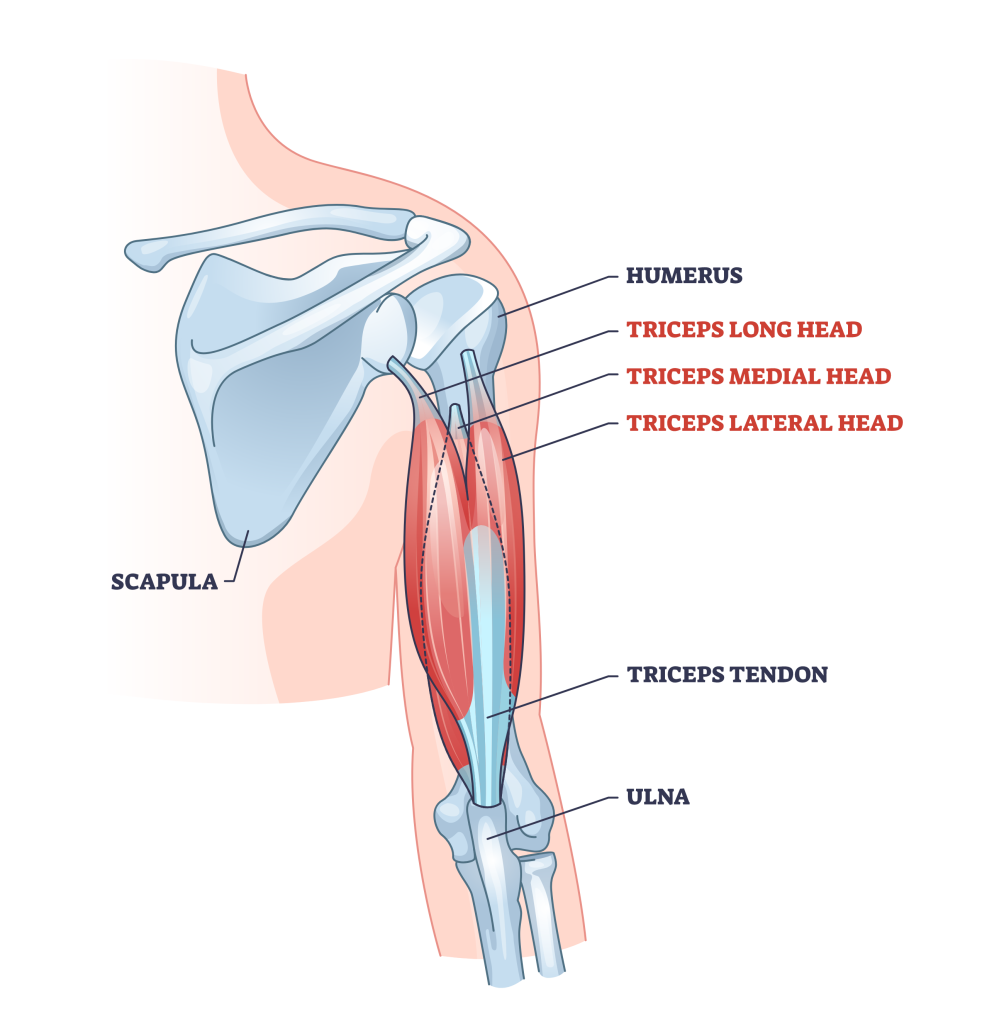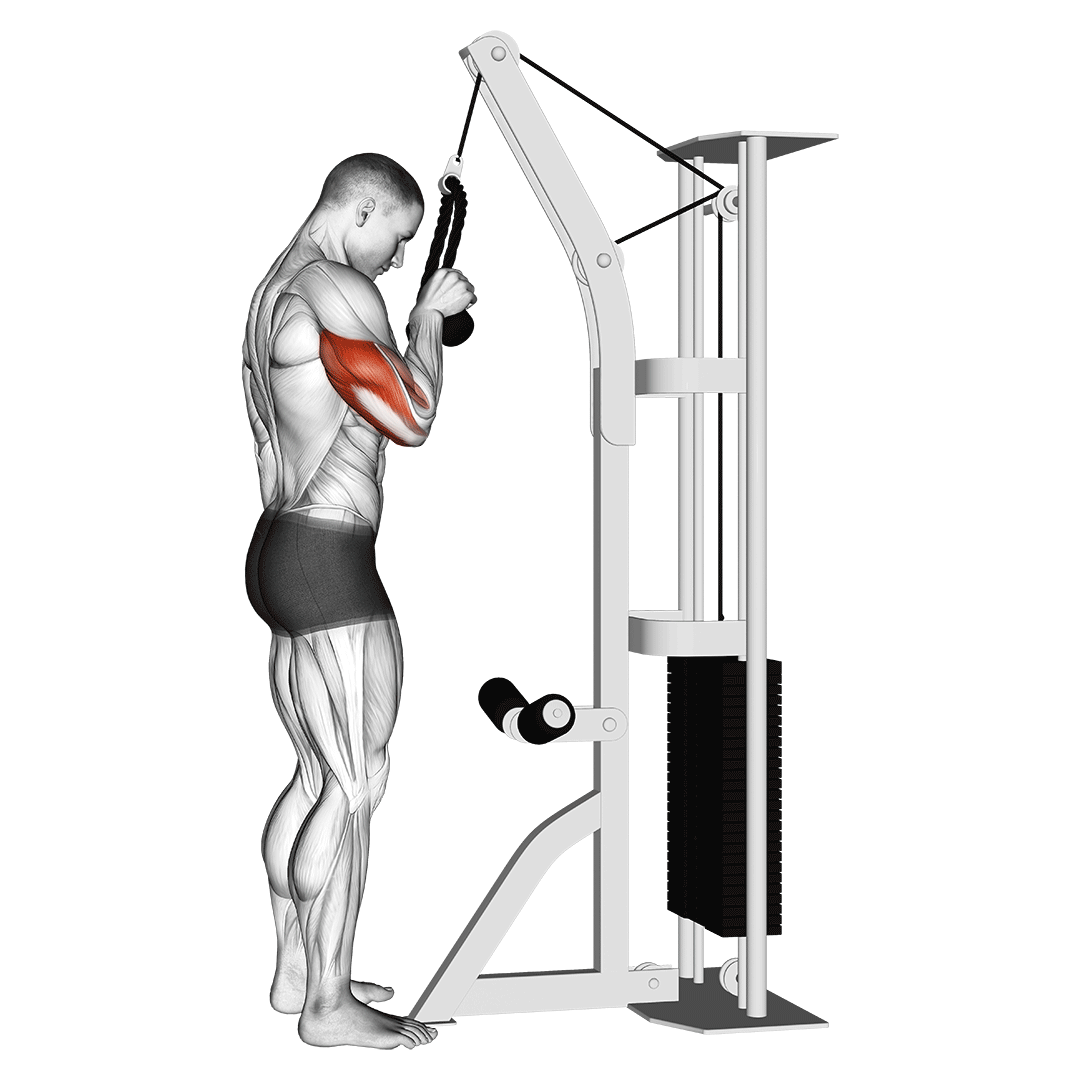Tricep Overhead Extension: Benefits, Muscles Worked, and More
Be it with a barbell or dumbbell, the overhead triceps extension is synonymous with building up massive and well-defined arms. Its isolated recruitment of the triceps and high capacity for volume make it especially useful as an accessory movement in bodybuilding workouts.
But, before adding this rather effective triceps exercise into your routine, it's important to first understand what makes it so unique in the first place.
In a nutshell, the tricep overhead extension (or simply “overhead extension”) is a free weight exercise involving the lifter raising their hands behind their head before extending the elbows with a weighted object held between their hands.
What are Tricep Overhead Extensions?
From a more technical standpoint, overhead extensions are a single-joint compound resistance exercise primarily performed for the purposes of inducing muscular hypertrophy of the triceps brachii muscle group.

Due to its emphasis on the triceps, tricep overhead extensions are primarily used as an accessory movement during push day or chest-and-triceps workout sessions, where they act as a source of low-resistance training volume.
Who Should Do Tricep Overhead Extensions?
Tricep overhead extensions are relatively simple, and are entirely appropriate for weightlifters of all experience levels.
In particular, however, overhead extensions are most useful for lifters seeking hypertrophy of the triceps in an isolated manner.
How to Program Tricep Overhead Extensions
Tricep overhead extensions are most useful when programmed as an accessory movement, and as such each set should not be performed at an excessively high level of intensity.
This means placing the overhead extensions after heavier compound exercises in the session have already been completed.
In terms of volume, a good starting point is 3 sets of 8 repetitions, although lifters seeking greater hypertrophy may increase it to 3 sets of up to 16 repetitions.
How to Do Tricep Overhead Extensions
To perform a repetition of overhead tricep extensions, the lifter will stand upright or be seated with a dumbbell held behind their head between both hands or with a single hand with the other hand/arm supporting the elbow.
The elbows should be parallel with the sides of the head and the palms facing upwards as they hold the weight.
Then, ensuring that the triceps are contracted as much as possible, the lifter will extend their arms upwards until the dumbbell is held overhead.
From this position, the lifter will continue by once more lowering the dumbbell, bending at the elbows and squeezing their triceps as they do so.
Once the dumbbell has returned to its original position behind the lifter’s head, the repetition is complete.
What Muscles are Worked by Tricep Overhead Extensions?
Because tricep overhead extensions are an isolation exercise, they will only work a single muscle group to any meaningful capacity - that being the triceps brachii.

In particular, it is the inner or long head of the triceps that will receive the greatest benefit from the exercise - although the entire muscle group itself will be developed, regardless.
What are the Benefits of Doing Tricep Overhead Extensions?
Apart from the kind of benefits one sees from all types of resistance training, overhead extensions are also capable of imparting several other effects that come in useful for lifters of all disciplines.
Excellent for Building Up Triceps Mass
Even among other triceps isolation exercises, few are as effective at recruiting the triceps brachii as overhead extensions.

When performed with the correct form and the right kind of programming, this level of activation can lead to significant muscular hypertrophy - or what is otherwise known as building muscle mass.
Unique Angle of Resistance
The majority of exercises that work the triceps do so with a horizontal angle of resistance (such as in the case of pressing movements). While this is perfectly effective in its own right, lifters may find that adding further variation to their triceps training can aid in maintaining progressive overload.
Furthermore, a vertical angle of resistance may aid in the development of task-specific triceps brachii strength, such as in the case of basketball shooting and certain Olympic weightlifting movements.
Elbow Extension Reinforcement
The triceps brachii are the primary muscle group responsible for elbow extension - or what is otherwise known as straightening the arm at the elbow. As the triceps grow weaker with age or injury, the biomechanic of elbow extension also becomes less stable.
Tricep overhead extensions help combat degeneration of the triceps brachii, and as a result are also capable of reinforcing elbow extension in terms of both stability and actual range of motion. This, of course, requires that the lifter already possess elbow joints capable of performing the exercise safely.
For the best results, performing a mobility drill prior to tricep overhead extensions is ideal.
Carryover to Other Exercises Like the Bench Press and Military Press
Despite the unique angle of resistance, overhead triceps extensions are capable of creating carryover training developments to other “push” exercises like the bench press and military press.
The triceps brachii are utilized extensively in the majority of compound push exercises, and as such any additional growth that may be derived from accessory movements like the triceps overhead extension will directly improve performance of said compound exercises.
In order to maximize the carryover from overhead tricep extensions to other exercises, lifters may wish to regulate set volume and tempo so as to produce a more performance-based growth of the triceps.
Common Tricep Overhead Extension Mistakes
Although tricep overhead extensions are relatively safe when performed correctly, making the following mistakes can easily result in poor training stimulus or even injury.
Hyperextending the Back
Though it may be tempting to curve the back for an easier time stabilizing, doing so can place the spine and shoulder joints in a potentially disadvantageous position - increasing the risk of injury significantly.
During each repetition of the overhead tricep extension, lifters should keep their torso relatively straight, with the chest pushed forward but the spine in a neutral curvature.
“Dropping” the Weights
During the latter half of the repetition where the weight is being lowered back down, failing to control the momentum can result in excessive shear force being placed on the elbow joints. This can negate a significant portion of the training stimulus, as well as significantly increase risk of injury.
Throughout each repetition, the tricep overhead extension should be performed in a slow and controlled manner so as to maximize time under tension and ensure that no injuries occur.
Jutting the Neck Forwards
Just as how curving the back can draw parts of the body into a potentially disadvantageous position, so too can sticking the neck forwards endanger the cervical portion of the spine.
In order to avoid poor form adherence and potentially straining the tissues of the neck, it is best to keep the head in-line with the torso as the overhead triceps extension is performed. If the lifter is having trouble lowering the weights behind their head, additional shoulder mobility work may be needed.
Tricep Overhead Extension Variations and Alternatives
For lifters who require an exercise of similar mechanics to the overhead triceps extension, there are a number of possible variations and alternatives that can fit the bill.
Be it due to a need for greater training specificity or simple dislike of the exercise, there is doubtless a perfect substitute for any training goal.
1. Overhead Cable Extensions
In training programs where the conventional overhead extension’s capacity for hypertrophy is insufficient, one may perform the machine-based variation instead.

Like most other machine-based exercises, overhead cable extensions will feature a comparatively reduced risk of injury and lengthier time under tension - two aspects that the conventional overhead extension already excels at.
When substituting free weight overhead extensions for their cable machine counterpart, it is best to reduce the level of resistance and increase volume so as to best take advantage of the latter exercise’s benefits.
2. EZ-Curl Barbell Skull Crushers
For lifters who find the general position of overhead tricep extensions to be uncomfortable, one alternative is to perform skull crushers instead.
Skull crushers replicate the mechanics and muscular recruitment pattern of overhead extensions - only with the lifter lying on a bench. Not only does this aid in proper form adherence, but it also allows for greater loading to be utilized as the angle of resistance will not be parallel to the torso.
For the easiest time loading and controlling the weight, perform skull crushers with the use of an EZ-curl barbell.
3. Triceps Pushdowns
As an alternative triceps isolation exercise of similar function, tricep pushdowns may be used to replace tricep overhead extensions in training programs where hypertrophy and high volume sets are the goal.

Unlike overhead tricep extensions, tricep pushdowns do not involve overhead extension of the elbows, or even any sort of resistance that takes place above the body. This can allow lifters with poor shoulder mobility to use tricep pushdowns as an alternative exercise without irritating their shoulders - although a medical professional should be consulted beforehand.
Because of the far more advantageous positioning of tricep pushdowns, using them as a substitute for tricep overhead extensions means that more resistance may be used.
Frequently Asked Questions (FAQ)
Is the Overhead Triceps Extension "Good"?
Yes - the overhead triceps extension is an excellent tool for building up the muscles of the arms.
Despite its initially awkward stance, the overhead extension can allow for a unique angle of resistance to be created within an upper body workout, resulting in greater muscular hypertrophy and strength adaptations.
What is the Difference Between Skull Crushers and Overhead Extensions?
Skull crushers are primarily performed lying down, with the arms bent over the face. Overhead extensions, on the other hand, are usually performed upright with the arms behind or at the sides of the head.
While the position is different, both exercises are used to target the triceps brachii in much the same manner, and are sometimes used interchangeably in the role of accessory isolation exercises.
Do Triceps Overhead Extensions Target All 3 Tricep Heads?
Yes - triceps overhead extensions are capable of working all three heads of the triceps brachii.
In particular, they will place the most emphasis on the long head of the triceps muscle group - of which is the most difficult portion of the tricep to target.
In Conclusion
The overhead extension is a must-have in any serious tricep workout. When it is done with respect to proper form and programming, there are few exercises quite like it.
If at any point you begin to experience pain, tingling or a “clicking” sensation in the elbows and shoulders during the exercise, it is best to stop performing it and to ask a qualified medical professional for an evaluation.
References
1. Sumiaki Maeo, Yuhang Wu, Meng Huang, Hikaru Sakurai, Yuki Kusagawa, Takashi Sugiyama, Hiroaki Kanehisa & Tadao Isaka (2022) Triceps brachii hypertrophy is substantially greater after elbow extension training performed in the overhead versus neutral arm position, European Journal of Sport Science, DOI: 10.1080/17461391.2022.2100279

